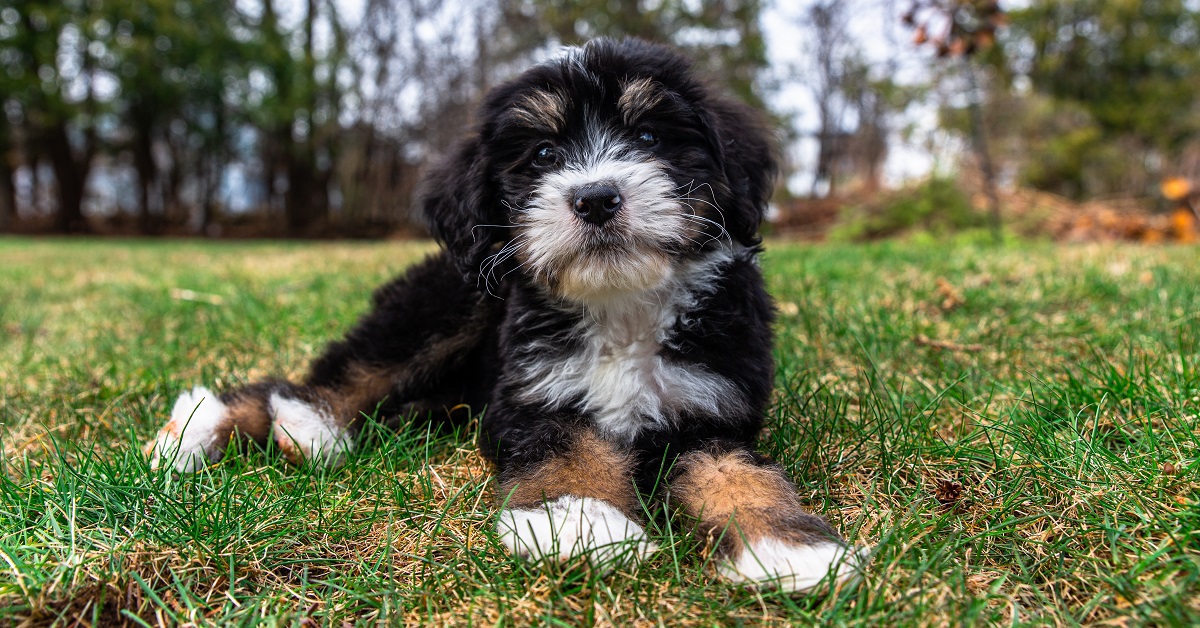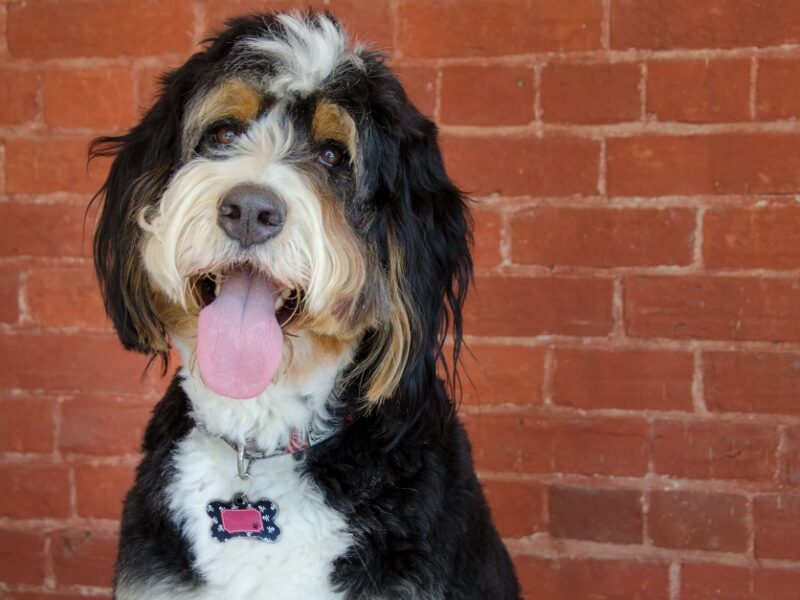The Bernedoodle’s sublime disposition, and its novelty, are certainly contributing to its rise in popularity. But perhaps the most common attractant to the relatively new breed, and to the great wide world of Doodles in general, is the lure of their hypoallergenic coats. Here we’ll discuss the variations in the Bernedoodle coat, and whether they are truly hypoallergenic, and what that actually means.
Bernedoodle Coat Type
The Bernedoodle can technically have three types of coats—straight, wavy, or curly. Those that have a coat that more closely resembles the Bernese Mountain Dog’s will be straight or wavy. These coats will shed, but are much less likely to have painful matting.
But, more likely, your Bernedoodle will have curlier hair, especially depending on which generation they are, as we’ll discuss momentarily. The more strictly Poodle DNA they have, the curlier hair they will have. This will mean there will be very minimal shedding. However this type of hair also mats more easily, so you’ll need to be more proactive about grooming them yourself.
The Bernedoodle coat can have any number of colors, like variations of black, white, and tri-color. A first generation pup, or an F1, is the straight-up result of a Bernese Mountain Dog and a Poodle. And even these are usually light shedders.
We’ll soon get into what hypoallergenic actually means, but if your goal is to find a Bernedoodle that is that, you’re best off looking for what the experts call an F1b, which is the result of breeding an F1 Bernedoodle and a Poodle. This means these pups are 75% Poodle and just 25% Bernese Mountain Dog. These dogs will shed just a bit, or not at all.
The F2b is another option, that’s slightly less Poodle than the F1b. It’s an F1 x F1b mix, which is 62.5% Poodle and 37.5% Bernese Mountain Dog.
Hypoallergenic: Fact vs. Fiction
Sorry to break it to you, but no dog is truly “hypoallergenic.” But some breeds—yes, Bernedoodles included—are easier to be around for those prone to allergies. Most people allergic to dogs aren’t actually allergic to the hair so much as the dander under it. Proteins in the saliva, urine, and feces also contain allergens, so it’s the combination of those plus the hair that gets spread around your house when your dog sheds, that makes some people react.
The term hypoallergenic, when talking about dogs, refers to those that are hairless or don’t shed, have a type of hair that’s less likely to produce a reaction, or not much dander.
No matter who your dog is, it’s hard to avoid allergens completely. You can keep them at bay by keeping your home clean and grooming your dog regularly to get rid of excess hair, and dandruff and other things that may be hiding in there. Even dogs that are more on the hypoallergenic side can trigger your allergies from time to time. But the bottom line is…yes, Bernedoodles are on the hypoallergenic end of the spectrum, especially if they have more Poodle DNA in them, since they’ll have curlier hair that won’t shed much.
So…How Much Hair Will I Be Cleaning Up?
Probably not much! Again, your Bernedoodle’s coat type can be somewhat predicted if you know what generation he is, or by looking at his parents and siblings from past litters. It depends also how strongly the Bernese Mountain Dog traits are in them. Bernedoodles do tend to be low shedders, which means there’s not dander being spread around your home, meaning you’re less likely to sniffle your dog’s days away. Your Bernedoodle’s breeder may be able to tell as early as a few weeks after birth what kind of a coat each puppy will have. So if you do struggle with allergies and having a pup that won’t cause reactions is particularly important, ask your breeder early on if she can match you up with one that suits your needs, with a curlier coat.
The Art of Grooming the Bernedoodle
There’s no such thing as a free lunch, and…there’s no such thing as a nearly non-shedding dog without a bit of a tradeoff. Since most Bernedoodles don’t shed much at all, they don’t naturally lose the dead or tangled hair that other dogs do. So they’ll need your help removing said hair. Leaving it untouched will result in painful matting.
You should brush your Bernedoodle at least once a week, and some even suggest as frequently as every day. And even beyond that, a haircut is recommended every 8-12 weeks. The curlier the coat, the more grooming is needed to avoid matting. The good news is that these good-natured dogs tend to enjoy brushing (assuming you haven’t waited too long and matting has begun!), and it can be a wonderful bonding activity for you and your friendly, people-pleasing Bernedoodle.
So yes! If you’re preparing your home for a Bernedoodle, you have a beautiful combo-black, brown, and white, almost-hypoallergenic-coated furry friend to look forward to. While there’s no way to guarantee you’ll be completely allergy-free, if your dog is a more Poodle-heavy variety, there’s a good chance your itchy, runny nose and eyes as a result of shedding and proteins being spread around your house, will be minimal to non-existent.


